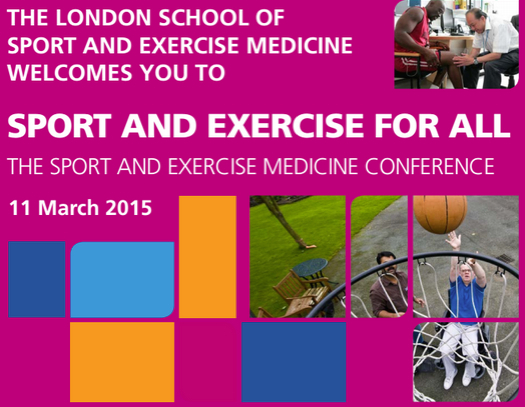Sport and Exercise Medicine: The UK trainee perspective (A BJSM blog series)
By Florence Newton and Katy Hornby

The 6th annual London School of Sport and Exercise Medicine conference, “Sport and Exercise for All” (Hosted by Holborn Bars, March 11, 2015) certainly lived up to high expectations. 145 candidates from diverse backgrounds attended the expert presentations on key issues including: physical activity for the old, young, elite and the less athletic. Below, we summarize highlights from the day.
Tales from the Ballet: common problems encountered with performing athletes and dancers
In the morning, we heard from Dr Roger Wolman, Consultant Rheumatologist and Sports Physician, about ‘Tales from the Ballet’. Dr Wolman has been involved with Dance Medicine at a high level since the late 1980s, and has a great wealth of experience in the field. He highlighted the injury pattern and predisposing factors that are specific to an aesthetic athlete such as a dancer.
Mental health in sport
Dr Justin Yeoh, an ST6 in SEM who is an experienced physician in the world of football, delivered perspectives from his own experience on mental health in sport, with a particular emphasis on depression. He highlighted how common yet underreported mental health issues are in sport and how difficult they can be to manage.
Rehabilitation considerations for the older athlete
Rehabilitation considerations in the older athlete were then discussed by Mr Bruce Paton, an extended scope physiotherapist at UCLH. We were introduced to key physiological aspects that affect training in an older person. He showed us how muscle physiology and aerobic capacity changes with aging. However, we were reassured by his example of Olga, a 90-year-old masters athletics champion with 7 world age-group records!
‘Extreme Sports Medicine’ – Disability in sport
After a short break to encourage some physical activity, Dr Richard Weiler inspired us all with ‘Extreme Sports Medicine’. Dr Weiler is an expert within disability sport. He taught us to think not about an athletes’ disability, but rather about their extraordinary ability, grit, and determination, and what they can do against all odds. He described how amputees playing football on crutches use 8 times more energy than conventional football. This definitely requires a ‘can do’ rather than ‘can’t do’ mind-set.
Sedentary behaviour
On the other end of the spectrum, we are faced with the public health concern of widespread high levels of sedentary behaviour. Dr William Bird sits on the Physical Activity Programme Board for Public Heath England. He showed us how explaining some of the basic physiology of obesity and inflammation to patients can help their understanding of their condition and enforce behaviour change. The main emphasis should be on physical activity and how even without demonstrable weight loss, the resulting decrease in visceral adiposity has massive implications on a persons’ health.
To delivery and beyond: Exercise in pregnancy
After a lunch of indulgence, the best dessert selection you have ever seen and some networking, the afternoon session kicked off with a very educational lecture by Dr Eleanor Tillett on exercise prescription in pregnancy. Dr Tillett is an SEM consultant with vast experience in women’s elite sport. She explained how exercise is beneficial for both mother and foetus at all stages of gestation and provided examples of special considerations to take when faced with pregnant ladies of all pre-partum athletic ability. It is not just about the pelvic floor!
Paediatric Sports Medicine – top tips for managing the child and adolescent athlete
Dr Abosede Ajayi demonstrated how child and adolescent athletes are not just small adults. Their growth velocity, bone mineralisation and adolescent awkwardness to mention just a few all play a part in adding to injury risk and patterns. Whilst younger children may be more precise with localising sites of pain, which can help the doctor, the hormonal adolescent may require different history taking skills to gather any information!
Dr Ian Beasley, Head of Medical Services to the Football Association (FA)
Dr Ian Beasley, Head of Medical Services to the FA and team doctor to the England’s men team, gave the final talk of the day. Through many anecdotes and great pictures he described the eclectic mix of facilities you might find at worldwide venues and how the medical team prepares for international tournaments. He taught us how to make the most of the equipment we have at hand. For example, spin classes in a laundry room are a great way to acclimatise to hot environments!
Closing remarks
Dr James Thing provided an excellent closing summary for the day. As a newly qualified SEM consultant, he discussed the changing face of sports medicine and the challenges ahead for our speciality. However, all that attended may agree, the conference also demonstrated how SEM offers diverse and exciting personal and professional opportunities.
Overall the conference was a great success. Many thanks and congratulations go to Farrah Jawad and Jonathan Korgaonkar, both SEM ST4s, for organising an enjoyable and informative day.
******************************************
Florence Newton and Katy Hornby are both ST3 Sports and Exercise Medicine trainees in London. Florence came into SEM after Core Medical training and is an academy doctor at Arsenal FC. Katy has a background of A+E training and works with the England Womens Rugby team.